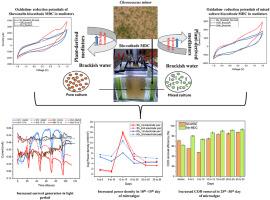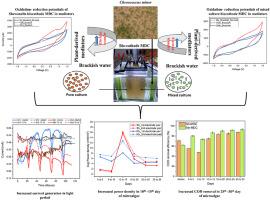一种新型微生物海水淡化电池中增强生物能和生物修复的小绿球菌阴极和多酚介导阳极
IF 7.3
2区 环境科学与生态学
Q1 ENVIRONMENTAL SCIENCES
引用次数: 0
摘要
在微生物海水淡化电池(MDCs)中,藻类生物阴极为化学阴极提供了一种可持续、经济的替代品。本研究以西米废水为阳极液,在中央海水淡化室中加入30 g/L NaCl,在新型同心布置的海水淡化室中,利用希瓦氏菌MTCC 8104 (Sh-MDC)和混合培养(mc -MDC)外电,评估了小红球菌作为生物阴极的作用。在30天内监测微藻生长对MDC性能的影响。Sh-MDC的峰值功率密度为31.7±0.6 mW/m2,而Mx-MDC在10-15天达到20.8±0.4 mW/m2,与非生物mdc相当。在25-30天期间,Mx-MDC记录了最高的COD去除率(92.9±2%),同时从西米废水中显著去除金属(Al, Ag, Pb)。微生物群落分析显示,Mx-MDC具有高丰度的致电种群。评价了该系统在淡化室微咸水处理中的应用。为了提高阳极室的性能,在阳极室中添加了植物源介质——香根草(Chrysopogon zizanioides)和葱皮提取物。与非介导体系相比,紫杉碱介导的Mx-MDC的功率密度增加了1.98倍。COD去除率和海水淡化效率分别提高到94.3±1.9%和21.5±0.43%。因此,紫荆提取物是一种可持续的介质,可以增强Mx-MDC对Sh-MDC的性能。优化产电种群和使小c适应半咸水环境可以进一步提高MDC效率,而收获的藻类生物质具有潜在的再利用潜力,支持循环经济。本文章由计算机程序翻译,如有差异,请以英文原文为准。


Chroococcus minor cathode and polyphenolic mediated anode for enhancing bioenergy and bioremediation in a novel microbial desalination cell
The algal biocathode offers a sustainable, cost-effective alternative to chemical cathodes in microbial desalination cells (MDCs). This study evaluated Chroococcus minor as a biocathode with Shewanella putrefaciens MTCC 8104 (Sh-MDC) and mixed culture (Mx-MDC) exoelectrogens in a novel concentrically arranged MDC using sago effluent as anolyte and 30 g/L NaCl in the central desalination chamber. The influence of microalgal growth on MDC performance was monitored over 30 days. Sh-MDC achieved a peak power density of 31.7 ± 0.6 mW/m2, while Mx-MDC reached 20.8 ± 0.4 mW/m2 between days 10–15, comparable to abiotic MDCs. Mx-MDC recorded the highest COD removal (92.9 ± 2 %) between days 25–30, along with significant removal of metals (Al, Ag, Pb) from sago effluent. Microbial community analysis of Mx-MDC revealed a high abundance of electrogenic populations. The system's application for brackish water treatment in the desalination chamber was assessed. To improve performance, plant-derived mediators, Chrysopogon zizanioides (vetiver) and Allium cepa (onion) peel extracts were added to the anode chamber. The C. zizanioides-mediated Mx-MDC exhibited a 1.98-fold increase in power density compared to non-mediated systems. COD removal and desalination efficiencies improved to 94.3 ± 1.9 % and 21.5 ± 0.43 %, respectively. Thus, C. zizanioides extract is a sustainable mediator enhancing the performance of Mx-MDC over Sh-MDC. Optimizing electrogenic populations and adapting Chroococcus minor to brackish conditions can further improve MDC efficiency, while the harvested algal biomass offers potential reuse, supporting a circular economy.
求助全文
通过发布文献求助,成功后即可免费获取论文全文。
去求助
来源期刊

Environmental Pollution
环境科学-环境科学
CiteScore
16.00
自引率
6.70%
发文量
2082
审稿时长
2.9 months
期刊介绍:
Environmental Pollution is an international peer-reviewed journal that publishes high-quality research papers and review articles covering all aspects of environmental pollution and its impacts on ecosystems and human health.
Subject areas include, but are not limited to:
• Sources and occurrences of pollutants that are clearly defined and measured in environmental compartments, food and food-related items, and human bodies;
• Interlinks between contaminant exposure and biological, ecological, and human health effects, including those of climate change;
• Contaminants of emerging concerns (including but not limited to antibiotic resistant microorganisms or genes, microplastics/nanoplastics, electronic wastes, light, and noise) and/or their biological, ecological, or human health effects;
• Laboratory and field studies on the remediation/mitigation of environmental pollution via new techniques and with clear links to biological, ecological, or human health effects;
• Modeling of pollution processes, patterns, or trends that is of clear environmental and/or human health interest;
• New techniques that measure and examine environmental occurrences, transport, behavior, and effects of pollutants within the environment or the laboratory, provided that they can be clearly used to address problems within regional or global environmental compartments.
 求助内容:
求助内容: 应助结果提醒方式:
应助结果提醒方式:


